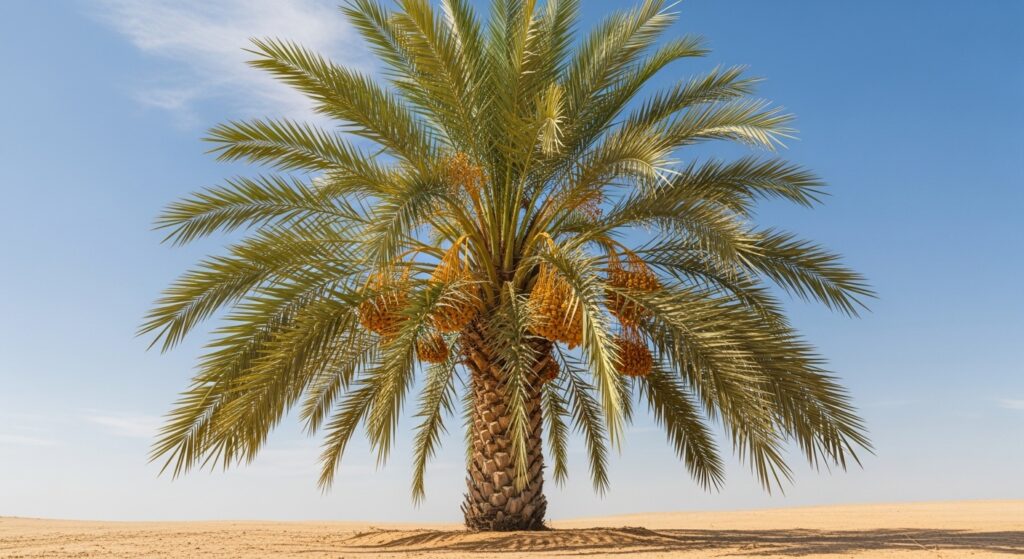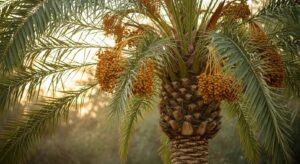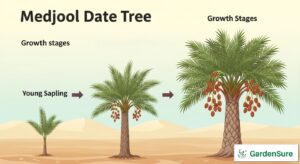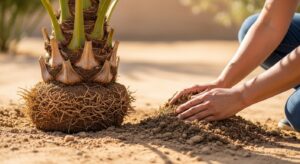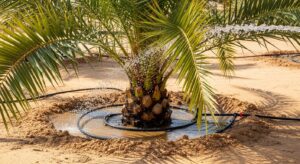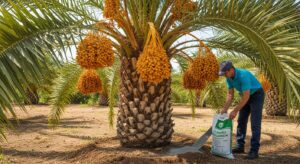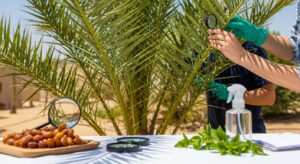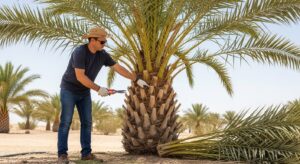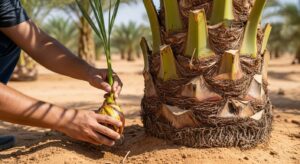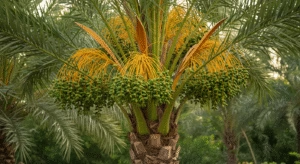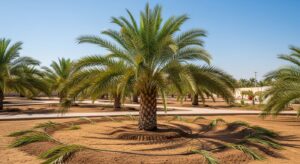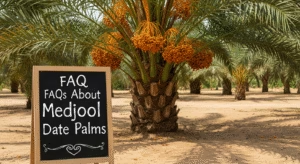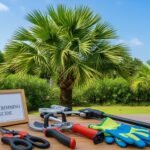Introduction to the Medjool Date Palm Tree
Medjool date palm tree (Phoenix dactylifera ‘Medjool’) is a plant that is a majestic and iconic emblem, which can easily change a landscape into an oasis-like, rich place to stay. With its towering height, feathery fronds, and caramel-sweet, delicious dates, this tree is known as the best choice for gardeners who want to add both decorative beauty and edible rewards from the plants. This type of palm is originally from the dry deserts of Northern Africa and the Middle East. The Medjool date palm tree grows in these warm and sunny areas; therefore, it is suitable for USDA hardiness zones of 9-11, especially with careful management. However, it can also adapt to slightly cooler regions.
The unique combination of beauty, usefulness, and cultural heritage of a Medjool date palm tree can be achieved by growing it. The dates it bears are not just a sweet snack but also a power food that provides fiber, potassium, magnesium, and antioxidants. More than its fruit, the tree with its elegant form brings shade, increases the value of property, and gives the viewer a sense of ageless beauty. The Medjool date palm tree not only appeals to beginner gardeners but also to professional horticulturists since it is a journey characterized by the combination of patience, care, and the joy of nurturing a living legacy.
This guide will provide you with everything you will need in order to care for 10 essential care tips and to allow you to grow a thriving Medjool date palm tree. This guide is especially created for beginners and addresses all the care details from the choice of a planting site to the harvesting of your own dates. The shared suggestions are from the experts; if you followed the advice in this guide, you would be able to grow a strong and diverse medjool date palm tree that would be proof of your gardening ability.
Let us find out why it is worth growing a Medjool date palm tree and how you can do it well in your garden.
Why Should You Select a Medjool Date Palm Tree?
The Medjool date palm tree is a plant- it’s a beauty statement and a utility. You can grow it for the following reasons:
- Gorgeous Appearance: The strong trunk and the bending fronds will definitely create a striking point for any tropical or desert-style garden.
- Eat the Fruit: The Medjool date is the ultimate way to reward yourself with a sweet and healthy treat, also helping you with digestion and energy levels.
- Low maintenance: No worries for these palms! After they are planted, they are drought-resistant and need less maintenance, making them the perfect solution for people who are busy.
- Historical and Cultural Prominence: People have been growing date palms for at least 6,000 years, and they have been a symbol of wealth and strength in many communities.
- Help Environmental Health: Palm trees give you shade, stabilize the soil, and attract wildlife, all of which help in making a sustainable ecosystem.
Knowing the Growth Habits of the Medjool Date Palm Tree
Before you actually plant a medjool date palm tree, it is great to first learn about its characteristics:
- Height: It can grow to 40-60 feet or even more
- Growth Rate: These palms can grow 1-2 feet in a year, depending on water, soil, and care.
- Lifespan: Approximately a century to a century and a half, they can produce fruit for decades with proper care.
- Fruiting: They usually produce dates when they are about 7-10 years of age and grow the most fruit when they reach 15-20 years.
- Dioecious Nature: The palm tree range consists of male and female trees; the tree bears fruit if there is sufficient pollination.
With this foundation, you can proceed to the top 10 care tips that will keep your Medjool date palm tree healthy and fruitful.
Tip 1: Choose the Correct Spot for Your Medjool Date Palm Tree
Choosing the right place to plant is crucial for the long-term health and productivity of your Medjool date palm tree. These trees love exposure to the sun; it is recommended that you give them daily a full 6-8 hours of sunlight for photosynthesis, growth, and excellent fruit production. Putting them in a shaded area or a partially shaded area may cause weak growth and less fruit production.
Decisive Factors to Consider When Selecting the Location
Climate Compatibility: The best USDA zones for Medjool date palms are 9-11, where winter temperatures rarely go below 20°F. In cooler zones (e.g., zone 8), it is a good idea to grow them in containers and protect them during the winter.
Space Requirements: A mature palm tree can be a tree with a crown span of 20-30 feet and an extensive root system. It is advisable to plant it at least 15-20 feet away from buildings, fences, or other trees to avoid competing and causing any structural damage.
Wind Protection: Although the Medjool date palm tree is a firm species, the young trees could be affected by strong winds that break branches or make them fall. It is better to choose a place that has natural windbreaks, such as hedges, walls, or even to install temporary barriers for baby plants.
Drainage: Do not select low areas where water collects and wets the soil, as it can cause root rot.
Common Location Mistakes to Avoid
- Planting too close to structures which restrict root and canopy growth.
- Choosing a north-facing site with limited sunlight leads to poor development.
- Ignoring overhead obstacles like power lines, which pose safety risks as the palm grows.
Expert Tips for Optimal Placement
- Opt for a south- or west-facing location to capture maximum sunlight.
- Use a sunlight calculator app to confirm your site receives adequate light year-round.
- Create a microclimate by planting near a heat-retaining wall or pavement to boost warmth in borderline zones.
- Consult local zoning regulations to ensure compliance with height and placement restrictions.
When you make a careful choice for planting your Medjool date palm tree, you will boost the tree’s growth with increased fruit production.
Tip 2: Create Good Soil Conditions for Your Medjool Date Palm Tree
Soil is the bedrock of your palm’s health. The Medjool date palms thrive in sandy, well-draining soils that are reminiscent of their desert origins. The right arrangement of soil gives rise to shallow roots, better absorption of nutrients, as well as immunity from diseases like root rot.
Best Characteristics of Soil
- Texture: The best soil is sandy loam or loamy sand, as it allows fast drainage while still retaining some water. Heavy clay or hardened soils must be modified to enhance the palm’s growth.
- pH Level: The ideal soil pH is 6.0-8.0, which is slightly acidic to slightly alkaline. You can test the soil with a pH kit from any garden store and make adjustments with lime (to raise pH) or sulfur (to lower pH).
- Drainage: Test the drainage by digging a hole 12 inches deep, filling it with water, and timing how long it takes to drain. If the water goes away within 30 minutes, drainage is fine, but if it takes longer, amendments are required.
How to Prepare Soil
- Digging the Planting Hole: Dig a hole two times wider and two times deeper than the root ball of the palm so roots can expand easily.
- Sow the Soil: Mix the native soil with 30% to 50% sand, perlite, or compost to improve drainage and aeration.
- Backfill Correctly: Refill the hole and make sure the trunk of the palm is at the original soil level.
- Tap Down: Firm the soil gently to break air pockets without excess compaction.
Dealing with Common Soil Hurdles
Clay Soils: Gypsum is the solution for breaking clay particles and improving drainage.
- Saline Soils: The palms are moderately salt-tolerant; they still prefer low salinity. If necessary, flush the soil with water to leach the salts.
- Nutrient-Poor Soils: Add mature compost or a slow-release fertilizer when planting to enhance the overall soil health.
Expert Tips for Soil Management
- Put a 2-3-inch gravel or small rock layer at the base of the holes to improve drainage.
- Do an annual re-test for pH and drainage to keep the soil at optimal levels.
- Use a soil probe to check for compaction or moisture retention at deeper levels.
- Think about drainable raised beds in areas of poor drainage to get roots above moist soil.
Correct soil work provides a sturdy basis for your Medjool date palm tree to grow and live a long life.
Tip 3: Learn the Best Watering Techniques for Your Medjool Date Palm Tree
Watering is an important part of caring for the Medjool date palm tree. The water needs of the trees differ with respect to their age, climate, and season. Water your palm in a way that neither excess nor deficiency stresses the plant and allows it to grow healthily.
Watering Philosophy by Tree Age
- Young Palms (1-3 Years): Water 2-3 times each week, giving 5-10 gallons at a time to encourage roots to go down deep. Frequent watering helps the plants to grow fast during this time.
- Mature Palms (4+ Years): Water once a week, and give them 15-20 gallons of water, adjusting for rainfall. These palms are drought-tolerant but do well with regular moisture.
- Container-Grown Palms: Do the soil daily, and water the palms if the first two inches get dry, which typically takes place every 2-3 days.
Seasonal Adjustments to Watering
- Spring and Summer: Increase watering frequency during the hot and dry cycles to avoid dehydration. In excessive heat, water twice a week.
- Fall and Winter: Omit watering (every 10-14 days) in colder areas to avoid waterlogging.
- Rainy Seasons: Observe nature’s rain, and refrain from watering if the soil seems damp.
Recognizing Watering Problems
Signs of Overwatering:
Yellowing plants, waterlogged soil, or a musty odor at the trunk are indications of too much moisture.
Signs of Underwatering:
Brown crispy tips on the fronds, wilted leaves, or slow growth could be a reason for a lack of water.
Water Management Techniques for Efficiency
- Deep Watering: Slowly apply water to reach a depth of 12-18 inches, thus promoting root growth.
- Drip Irrigation: Install a drip system with emitters placed around the drip line for consistent moisture delivery.
- Mulching: Place 2-3 inches of organic mulch (like wood chips or bark) around the base to keep the moisture content and regulate soil temperature.
Expert Tips for Watering Success
- Use a moisture meter to check the soil at a depth of 6–12 inches for precise watering decisions.
- Water in the early morning to minimize evaporation and fungal growth.
- Create a watering basin (a shallow ring of soil around the trunk) to direct water to the root zone.
- Avoid overhead watering, as wet fronds can attract pests and diseases.
- When you get the watering techniques right, you will succeed in keeping your Medjool date palm tree hydrated and healthy the whole year round.
Tip 4: Fertilize Strategically for Healthy Growth and Fruiting
Feeding your Medjool date palm tree with the right nutrients supports lush foliage, strong roots, and bountiful fruit. These palms require a balanced fertilizer rich in nitrogen, potassium, magnesium, and iron to thrive.
Best Fertilization Schedule
- When: Fertilize during the growing season (spring to fall) every 3 months, typically in March, June, and September.
- What: A slow-release granular fertilizer with an NPK ratio of 8-4-8, 10-10-10, or a palm-specific blend containing micronutrients like manganese and zinc is recommended.
- How Much: Young palms need 1-2 pounds, while mature trees need 3-5 pounds according to product instructions.
Organic vs. Synthetic Fertilizers
Organic Options:
The best slow-release nutrient providers are compost, well-rotted manure, and fish emulsion. Apply 5-10 pounds per tree per application.
Synthetic Options:
These palm fertilizers are efficient but must be used carefully to avoid salt buildup. Soil should be flushed with water monthly to leach out excessive salts.
Micronutrient Sprays:
Iron or magnesium-frond sprays will correct deficiencies, which are usually seen as yellowing fronds.
Application Techniques
- Spread evenly: Place fertilizer in a ring around the drip line, the location where feeder roots are abundant.
- Water Thoroughly: Make sure to water immediately after application so that the nutrients dissolve and the roots are not burned.
- Avoid Trunk Contact: Keep fertilizer 6-12 inches from the trunk to avoid damage.
Common Fertilization Mistakes
Neglecting Nutrient Deficiencies: Specific nutrients like nitrogen that plants lack might also cause yellowing or stunted growth; thus, testing the soil for such nutrients is imperative.
Expert Tips for Fertilization
- Conduct a soil test every 1–2 years to tailor your fertilizer regimen.
- Supplement with Epsom salts (magnesium sulfate) at 1/4 cup per tree monthly to boost magnesium levels.
- Rotate between organic and synthetic fertilizers to balance immediate and long-term nutrient availability.
- Monitor the frond’s color and growth rate to assess nutrient effectiveness, adjusting as needed.
- Keeping a strategic fertilization plan will help your Medjool date palm tree be at its best and will also lead to an increase in fruit.
Tip 5: Safeguard Your Medjool Date Palm Tree from Pests and Diseases
Medjool date palms are hardy, but they can be vulnerable to attacks from pests and diseases, which could risk their life. Therefore, the only way you can go is to do regular inspections and take preventive management measures.
Common Pests Affecting Medjool Date Palm Tree
- Red Palm Weevil: The larvae dig into the trunk, leaving the trees oozing sap, wilting fronds, or even falling. Proper precautions are the key.
- Scale Insects: Small, waxy pests that are found in the frond or trunk suck sap, later on, they cause yellowing or sooty mold.
- Spider Mites: Little pests make stipples or webs on the leaves; they flourish in dry and dusty settings.
- Date Palm Mite: These microscopic pests undermine fruit quality by scarring fruit.
Common Diseases to Watch Out For
- Fusarium Wilt: This is a fungal disorder that leads to browning and the death of the fronds. It can be transmitted through improper tools or soil.
- Bayoud Disease: A roof fungus spoils roots, and it is mostly found in places with poor drainage.
- Graphiola Leaf Spot: it is characterized by black spots on the fronds; it worsens in humidity.
- Root Rot: Overwatering or poor drainage, the roots to be soft and colored.
- Prevention Strategies
- Cultural Practices: Water, drain, and prune appropriately to reduce stress and vulnerability.
- Sanitation: If you want to avoid infection, sterilize your cutting tools with a 10% bleach solution.
- Monitoring: Inspect your palm tree regularly.
Tip 6: Prune Your Medjool Date Palm Tree with Purpose
Pruning is vital to your Medjool date palm’s well-being, beauty, and safety. Correct pruning involves the removal of dead or diseased fronds, improving air circulation, and preventing pest habitats while pest habitats are but not all over-pruning that can weaken the tree.
Pruning Instructions
- When to Prune: Aim to prune during the active growth phase of the tree in early spring or summer for a faster recovery.
- What to Remove:
- Dead, yellow, or brown leaves.
- Fronds that are broken or damaged due to storms.
- Fruit stalks that are old after harvesting.
- Basal suckers (offshoots) if not needed for propagation.
- What not to Remove: Never remove green fronds, as they are essential for photosynthesis and nutrient storage. Decrease canopy pruning limits up to 10-15% each year.
Tools and Techniques
- Tools: The use of palm-specific sharp, sterilized pruning saws, pole pruners, or shears is recommended. Chainsaws should be avoided as they create jagged cuts.
- Cutting Method: Cut the fronds 1–2 inches away from the trunk to avoid damaging the bark. Angle cuts will help with water shed and rot prevention.
- Safety: It is essential to protect yourself by wearing gloves, goggles, and a hard hat from falling fronds or spines.
Pruning for Aesthetics and Safety
- Remove fronds hanging below the horizontal plane (the “9 o’clock to 3 o’clock” rule) for a tidier look.
- Clear fronds near walkways or structures to prevent hazards.
- Trim fruit stalks to reduce weight and improve fruit quality in female trees.
Expert Tips for Pruning
- Sterilize tools prior to and after pruning to avoid the spread of diseases.
- Hire a professional arborist for palms exceeding 15 feet in height to assure safety and accuracy.
- Use pruned fronds for garden mulch or compost material but check them for pests first.
- Do not perform “hurricane cutting” (removing most fronds), as this will increase stress and reduce the strength of the palm
- Useful pruning operations promote both the appearance and the longevity of your Medjool date palm tree.
Tip 7: Preserve Your Medjool Date Palm Tree from Cold Weather
Medjool date palm trees are frost resistant to 20°F (-6°C) for a brief time frame, but they need some protection from the harsh cold during prolonged freeze conditions, especially in zones 8 or 9.
Cold Weather Protection Methods
- Mulching: Use 4–6 inches of organic mulch (e.g., straw, bark, or leaves) around the base, which will also help insulate roots, extending the tray out to 2–3 feet from the trunk.
- Trunk Wrapping: Wrap the trunk with burlap, frost cloth, or bubble wrap, securing with twine, to retain heat and prevent frost cracks.
- Crown Protection: Tie fronds loosely around the crown or cover with a frost blanket to shield the growing tip, the palm’s most vulnerable part.
- Heat Sources: For extreme freezes, wrap the trunk with non-LED string lights or apply frost heaters to provide additional heat.
Precautions During Cold Snaps
- Avoid Watering: Wet roots are more susceptible to freezing damage; pause irrigation during cold weather.
- Remove Coverings Promptly: Unwrap the tree after the freeze to prevent moisture buildup and fungal issues.
- Check for Damage: Check for mulch compaction against the trunk, which can lead to rot.
Assessing and Managing Cold Damage
Symptoms:
Signs of frost damage include brown or blackened fronds, soft trunk, or a drooping crown.
Recovery:
Wait until early spring to prune any damaged fronds, as they might improve or protect the new growth. A micronutrient spray fertilizer can aid recovery.
Expert Tip: If the crown is fragile, it’s best to call an arborist immediately, as crown damage can be fatal to the tree.
Expert Tips for Cold Weather Care
- Keep track of local weather reports by downloading weather apps for early warnings of freezes.
- Plant in a microclimate (e.g., near a south-facing wall or pavement) to reduce cold exposure.
- Use soil-warming cables for young palms in containers, and move indoors or to a greenhouse during winter.
- Apply a potassium-rich fertilizer in late summer to harden tissues before winter.
- Proper cold weather protection ensures your Medjool date palm tree survives winter and thrives in spring.
Tip 8: Propagate Your Medjool Date Palm Tree Effectively
The propagation of Medjool date palms enables the acquisition of new trees by oneself or having them to others. You can use offshoots (suckers)- these are genetic clones of the original tree, so that’s the most reliable method.
Offshoot Propagation Steps
- Select a Healthy Offshoot: Pick an offshoot that is 3-5 years old, which has a height of 12-18 inches and roots only at the base of the parent.
- Separate Carefully: Use a sharp, sterilized knife or shovel to cut the offshoot, retaining the most amount roots.
- Prepare the Offshoot: Treat the cut with fungicide to avoid any kind of infection and dust with rooting hormone to encourage growth.
- Plant immediately: Place in a well-draining mix (e.g., 50% sand, 50% compost), water deeply, and shade for the first 4-8 weeks.
- Acclimate Gradually: Transition to full sun over 2-3 weeks as the offshoots establish roots.
Seed Propagation Challenges
- Seeds are less reliable, as they may not produce non-Medjool traits and take 10–15 years to fruit.
- Soak seeds in water for 48 hours, plant them in sandy soil, and keep 80-90°F for germination (4-12 weeks).
- Success rate is 30-50%, and seedlings require 5-7 years to determine sex.
Post-Propagation Care
- Watering: Keep the soil uniformly moist without it becoming waterlogged, especially for the first year.
- Staking: Prop up offshoots with bamboo stakes when winds or storms attempt to tip them.
- Fertilizing: Apply a weakened liquid fertilizer (e.g., 10-10-10) monthly after two months for growth enhancement.
Expert Tips for Propagation
- Propagate in spring or early summer to align with the palm’s active growth period.
- Label offshoots to track their origin, especially if propagating multiple palms.
- Be patient, as offshoots may take 1–2 years to fully establish and resume normal growth.
- Purchase certified offshoots from a reputable nursery to ensure disease-free stock and true Medjool traits.
Propagation Success Story
Many growers find joy in propagating Medjool date palm trees from offshoots, creating groves that mirror their original tree’s beauty and productivity. For example, a California gardener propagated 5 offshoots from a 20-year-old Medjool, establishing a small orchard that began fruiting within 8 years. Patience and precision are key.
Tip 9: Be Patient with Medjool Date Palm Fruiting
Fruiting is the final reward of the Medjool date palm tree gardening, but it needs time, suitable conditions, and the right setup.
Fruiting Timeline and Requirements
- Age to Fruit: The palms generally start to give fruits at about 7–10 years of age, with the greatest yields of 50–150 pounds per tree being reached at around 15–20 years.
- Dioecious Requirement: Medjool date palm tree is either male or female. Fruit production requires both sexes for pollination, with one male per 20–30 female trees being ideal.
Pollination Methods:
- Natural: Wind or insects transfer pollen, but yields may be lower.
- Hand-Pollination: Gather the male flower and use it to spray or paint the pollen on the female flower.
- Environmental Factors: Warm temperatures (80–100°F), ample sunlight, and consistent nutrition enhance fruit development.
Factors Influencing Fruit Yield
- Tree Health: Drought, nutrient deficiencies, or pests could be the major reasons for low yield or poor quality.
- Climate: Cooler summers or high humidity can be factors that delay fruiting or cause wrong fruit ripening.
- Fruit Thinning: Remove 30-50% of the dates from each cluster.
Gathering Medjool Dates
- When: Collect in late summer to fall (September–November) when the dates are soft and amber-brown (soft stage).
- How: Medicinally, the whole fruit clusters must be cut down with shears while being careful to avoid bruising.
- After collection: Wash dates, dry them and store them in a cool, dry place or put them in the fridge for 6-12 months.
Expert Tips for Fruiting Success
- Know the sex of the tree earlier: Buy pre-sexed palms or note the flower spikes (males: pollen, females: fruit clusters) at maturity.
- Use a pollination kit for hand-pollination, available at speciality nurseries.
- Protect fruit: Cover clusters with mesh bags to shield from birds, insects, or debris.
- Track yields: Record annual harvests to monitor tree health and adjust care practices.
- Patience and the right pollination methods lead to fruitful rewards for your Medjool date palm tree.
Tip 10: Keep Your Medjool Date Palm Tree Environment Clean and Tidy
A neat garden will reduce the incidence of pests and diseases, beautify the area, and promote your palm’s overall health.
Maintenance Tasks for a Tidy Garden
- Clear Debris: Weekly removal of fallen fronds, fruit, and organic matter will keep pests like rats or ants away and inhibit the growth of fungal spores.
- Control Weeds: Use a hoe or pull out weeds around the base to cut out competition for water and other nutrients.
- Dispose of or Recycle: Fronds and fruit waste can be composted, but must first be inspected for pests or disease before being added to the pile.
- Clean Fronds: Fronds need to be washed with a hose at monthly intervals to get rid of dust, which increases photosynthesis and lessens habitats for mites.
Establishing a Maintenance Schedule
- Daily: Check for fallen fruit or debris, especially during harvest season.
- Weekly: Inspect for weeds, pests, or water issues.
- Monthly: Prune fronds, check soil moisture, and apply treatments if needed.
- Seasonally: Fertilize, refresh mulch, and prepare for weather changes (e.g., cold or heat).
Benefits of a Clean Environment
- Pest Reduction: Removes food and nesting areas for insects and rodents.
- Disease Prevention: Decreases moisture and fungi, which flourish in organic matter.
- Aesthetic Appeal: Improves the look of your garden and emphasizes the palm’s gracefulness.
- Soil Health: Prevents nutrient leaching and promotes nutrient cycling through composting.
Frequently Asked Questions About Medjool Date Palm Trees
How tall does a Medjool date palm tree grow?
Medjool date palms are usually 40–60 feet tall, with some exceeding 80 feet in decent conditions. The growth rate is usually 1-2 feet yearly, depending on care and climate.
Can I grow a Medjool date palm tree in a pot?
Young palms do well in 20-30 gallon pots for 3-5 years, which are both perfect for patios and small spaces. It is, however, better that ground planting is done for mature palms because of their massive root system.
Are store-bought Medjool dates the same as those from my tree?
You bet, the store-bought Medjool dates are of the same variety, meaning they will be grown with the same sweet, rich flavor as the ones you grew in it. Possible different tastes from homegrown dates are due to the immediate taking of them.
How long does it take for a Medjool date palm tree to fully mature?
Going to full maturity is a long journey that will take around 15-20 years, with the fruiting starting at 7-10 years and the peak production at 15-20 years. Medjool date palms can live longer than 100 years.
How do I determine if my Medjool date palm is male or female?
Male palm trees have flower stalks that are heavy in pollen, while females create fruit clusters. Nurseries often carry labels showing the sex or flowering may be noticed (normally at 5 to 7 years).
Can Medjool date palms survive extreme heat?
Yes, as long as they receive as much water as necessary and are planted in well-draining soil, they can stand temperatures up to 120°F (49°C). Mulching is of great help in soil heat management, too.
What is the best time to plant a Medjool date palm tree?
Spring or early summer is the perfect time to plant to help the roots establish before winter. Stress transplant shock is most likely avoided by preventing planting during very cold or hot weather.
Conclusion: Start Your Journey with the Medjool Date Palm Tree
Cultivating a Medjool date palm tree is not only an entertaining journey but also combines horticulture, attention to the environment, and fruiting and enjoying the sweet and healthy dates that one grows. Just by following these top ten care tips, which include picking a sunniest spot to clean up the garden, you will grow a strong palm tree that will help and beautify your space for many years to come by providing shade, beauty, and fruits.
Whether you are a novice or an expert, the Medjool date palm tree will always be an adventure. Start by choosing the right place to plant, testing the soil, and buying a palm tree from a trustworthy nursery. After a while, the tree will grow, and you will have the satisfaction of taking care of the tree and watching it produce many leaves and lots of fruit.
Are you ready to convert your garden to feature the Medjool date palm tree?
Hop on this amazing journey, decide on a site that receives a lot of sunlight, prepare your soil and enjoy planting. Your palm quest has started right now!
Use the comments section below to tell us your journey, whether progress, challenges, or successes, to motivate and connect with fellow gardeners. Let’s build a Medjool date palm tree community together, and happy gardening!

